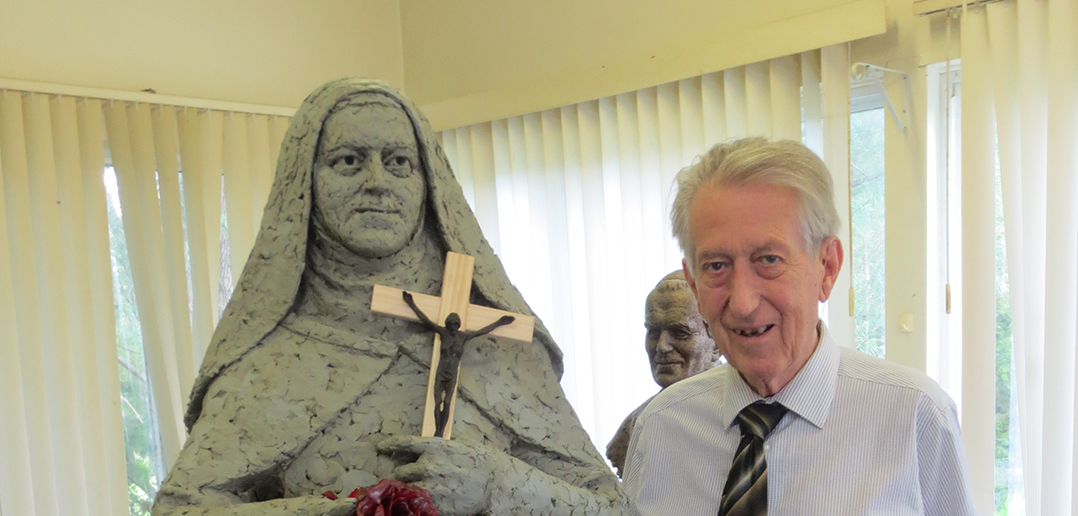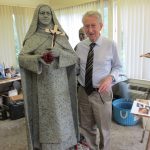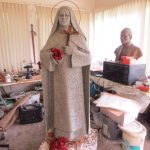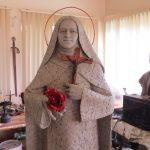
This summer, our little family has been blessed by the generosity of neighbors who also happen to be fellow Catholics. Both of these neighbors – a husband and a wife – are gifted artists. H. Reed Armstrong and Roxolana Armstrong both have an artistic ardor and talent, and each has a reputation of their own for making beautiful Catholic art. Reed is a sculptor, and the lady of the house, Roxolana, is a painter — particularly of Sacred Icons. Thus, they complement each other in a wonderful way. What strikes an observer in both cases is how much their art, in their own unique ways, is permeated by their faith. Both are faith-full artists. Both inspire a greater faith in others with their art.
Additionally, Mr. Armstrong has been working for the propagation and defense of the Faith with his published writings. On two occasions, we were able to work together – first, Mr. Armstrong wrote an article on Freemasonic influence in the Catholic Church for a book honoring my husband upon his 70th birthday; he also drafted another article about the intellectual formation of Pope Francis. I recommend both works to our readers, for Mr. Armstrong has put together in his insights the fruit of many years of research in the larger fields of Modernism, Freemasonry and of the Occult.
But let us come back to how our own little family was recently blessed by the generosity of this special Armstrong couple. They have open-heartedly offered us, as they have done in the past, to make good use their own swimming pool for our children’s exercise and refreshment this summer. While we are so grateful for this precious gift in the middle of Virginia’s humid heat, there was something else that made this summer’s trips to the Armstrongs an additionally special event: the making of a statue of a saint.
As it happened, Mr. Armstrong received at the beginning of the summer a new artistic commission from a Catholic parish in Texas, namely: to make a statue of St. Thérèse of Lisieux. Since the atelier of Mr. Armstrong leads out into his garden and the pool, our children and I were often able to stop by and to witness how this statue gradually came into being. We were, of course, aware, that one should not disturb an artist in the middle of his work. I cannot imagine how I would do in writing my own texts while someone was looking over my shoulder! (Too often, I remind our keenly inquiring children of that fact.) Thus the children and I would stop by the atelier at the end of a 3-hour period of work for Mr. Armstrong. As he says, he cannot work longer than that in one extended period of time, for he is then mentally exhausted. Nevertheless, he does not even notice how the time passes by when he is at his work.
At the beginning, the only visible element of the sculpture was a metal stake. A stand. Just a post, hand-made by some sort of wire going up and then coming down again. That is where St. Thérèse one day would stand. Then, Mr. Armstrong started to spread a sort of clay on it which is made out of all sorts of components that make it re-usable. What we realized is that, at the end, when the statue is made and a mold has been cast from it, the clay statue itself will be disassembled again and placed into one reusable pile of clay, and likely to be used one day again, for forming another statue. This seems to us indeed a humbling thing for an artist: to break down his creatively original work.
At that somewhat rough stage of the statue, Mr. Armstrong was so kind to make our children – our daughter and our son – into his little helpers. They were allowed to put here and there some small pieces of clay on the growing body of the statue. Mr. Armstrong’s method is largely “impressionist,” as he explained to us. He does not form one smooth body, but has the body look a little bit patchy and blotchy – which then will be somewhat smoothed over, but which will still preserve its sort of ruffled and patchy-looking surface which makes the statue more vividly alive than perhaps a smoother surface would appear. This slightly uneven surface “makes it more life like, just as the individual brushstroke of a painter,” said Mr. Amstrong. “I learned this method in the 1960s, and now it is for me too late to change it,” added the modest artist. (Mr. Armstrong lived and worked for many years in Spain and his art is inspired both by impressionist techniques and by the Spanish mysticism of St. Teresa of Avila.) The children happily added their own little blotches or patches to the body of St. Thérèse. She looked fuller now.
At some point, we were able to see how Mr. Armstrong – with the help of some chicken wire – put a sort of veil over St. Thérèse’s head. The chicken wire helps him to form a sharp and clean edge that would look like the end of a veil that is gracefully falling from St. Thérèse’s head as a part of the draping, fuller habit she now wears. Our children took special interest in the way Mr. Armstrong prepared the roses that were to be in St. Thérèse’s hands and at her feet. After buying some artificial roses in a craft shop, he dipped them into some heated wax so as to harden and stiffen them. In this form, they could be molded to be part of the cast for the statue. With great interest, our children investigated the roses, as well as the little heater and pot in which the wax was to be found. Later, a Crucifix was added in order to be put into the enfolding arms of St. Thérèse.
Every time we came for a visit to the atelier, St. Thérèse had grown and took more form. I remember at some point seeing her eyes develop. They were at first just a hole, with the pupils a little bit shaped. It is interesting to see how, a little later, this kind of “hole” can come to look like an eye! The face, however, was still quite rough. “St. Thérèse’ face is not easy to make,” Mr. Armstrong told us. “She does not have a bony face, but rather a more fleshy one which makes it harder to imitate.” In the atelier, many pictures of St. Thérèse lay around with the help of which Mr. Armstrong gradually, prayerfully, and meditatively tries to capture a composite of her features.
“Finally, an artist does not know how the art comes to pass. It is a mystery. There comes a spiritual element into art that one cannot fully explain,” said Mr. Armstrong when we asked him about his own inspired work. Both his wife and he are convinced that faith helps form their own art, and all artists’ work in such a very essential way. They both claim that they can see whether an artist has the Faith or not. Again, we come back to the mystical part of art. I hope they will one day write about it and explain it more fully to all of us. (As a matter of fact, Mr. Armstrong just gave a talk on this matter in Philadelphia!)
When we came back the next time to the atelier, St. Thérèse’s face had developed, but it was still somewhat rough, I thought. I even thought that one of her eyes was a little bit off. We then took our first photograph of the statue – with the artist standing next to it. Mr. Armstrong kindly called the children into the picture, as well. “It is also your statue, since you helped make it!,” he added in his sweet tone with which he so often addresses the little ones. Since we were on our way to our summer vacation, Mr. Armstrong asked us for our prayers for the final stage of his work. “I still can destroy it. One never is sure that it will come out right,” he said.
To be loyal to our promises to him, during our subsequent trip our daughter even lighted a candle in a church for the beautiful fruitfulness of Mr. Armstrong’s statue – and she even did it in front of another statue of St. Thérèse!
When we returned from our vacation on the seacoast – we ourselves had, as it were, a mystical experience! The statue of St. Thérèse stood there in the atelier, somewhat in the darkness, as if she were true and alive. Vividly real. As if you just could talk to her! And pray to her. That is why she was made. That is why Mr. Armstrong – together his wife Roxolana – does what he is doing. “To do something beautiful for God.”
When I showed my husband the photographs I had taken of the final statue, he was also deeply touched, especially by her countenance. He had followed all our stories along the way, seeing the glowing eyes of our children when they returned home and eagerly told him, for example, that they were able, once more, to put a little patch or so on St. Thérèse.
Now the statue has been sent off to be cast in another workshop, down in Southern Virginia. It will remain a risk-filled adventure – to include the precarious transport of a large statue made of clay – until the statue is there, where it will cast in bronze via the age old “lost wax process.” Mr. Armstrong explained this procedure as follows:
First, a flexible rubber mold will be made from this original statue, and then into that mold will be applied a layer of wax to produce an exact copy of the clay original. The wax model is then encased in high heat resistant investment silicon plaster and then, after a period of drying, is baked until all the wax drains out and the plaster is firmly fused into the final mold. Into the hollow left by the drained wax is poured the bronze (at 1,800 degrees Fahrenheit!) which will then finally be an exact reproduction of the original clay model to be shipped to its destination.
That is when the statue will be carefully sent to Texas (without Mr. Armstrong’s being able to even see for himself the final statue!). The local priest in Texas has already approved of the final work – to the great relief of Mr. Armstrong. We, of course, would wish that the statue could also somehow remain in Front Royal, Virginia. But even if she is now rightly to go to Texas, she will always also have a special place in our hearts – especially in the hearts of our young children.







Sugar Land or Austin?
My brother’s family are members in Austin, so I could see this IRL.
Thank you for this lovely post.
Sugarland —
Aww, too bad.
Dear Mr. Armstrong: Good fortune is with me. I will be visiting for the Thanksgiving holidays. My son has offered to drive me to Sugarland. I am very grateful for this opportunity to see and take pictures of your work. May God bless you and keep you. Phyllis Schabow
Thank you for this beautiful insight into the mediums, techniques and God given talent into the making of a statue of St. Therese. Art, truly is meant to give glory to God.
Please post the name of the parish in Texas! I will be traveling there in November. It may be a big state, but God willing, I will find it.
The church to which the statue is going is St. Theresa’s in Sugarland, Texas, a sburb of Huston. THe piece should be cast and delivered and in place by the end of October. If you ever do get to see it in place, drop me a line at [email protected]. God Bless!